The region of Burgundy in east-central France has a long-standing reputation as a food and wine capital, hive of historical relics and a paradise for lovers of the great outdoors. With so much to offer, its scenic hillsides and ancient paths are fairly well trodden, but it’s still possible to find some truly captivating hidden gems throughout Burgundy.
Gorgeous wines, scenic towns and rolling countryside, Burgundy is perfect for any type of holiday, be that a romantic getaway or family holiday. From vineyards to fine dining, take a look at the best places to visit on your next trip to Burgundy France, including some hidden gems.
Getting there and around
Burgundy is approximately five hours' drive from LeShuttle at Calais — just a 35-minute journey from the UK. There are two routes, one via Paris and the other via Reims. If you plan to visit Dijons, Beaune or Tournus, the Reims route is the one for you: take the A26 to Troyes and then follow it southeast. Vézelay is accessible from the same road, but you take the southern branch. Please be aware that French motorways carry tolls.
Driving to some of the vineyards and attractions further afield may require you to use your vehicle, but within Burgundy lies an extensive tram and train network that connects the main towns of the area. The Bourgogne liberté card grants 25% off weekday prices and 50% off weekend prices which will help to keep the costs down. For more information about what to do and where to stay, see the Burgundy Tourisme website.
When is the best time to visit Burgundy?
Although considered by many as particularly pretty in the autumn during the wine harvest and chilled air (great for those red wines), due to its pretty countryside and wealth of activities, Burgundy is beautiful all-year-round. Summertime is generally hot and dry, and spring brings billowing clouds and warm days and nights, with September to November bringing the colourful leaves.
Which cities are in Burgundy?
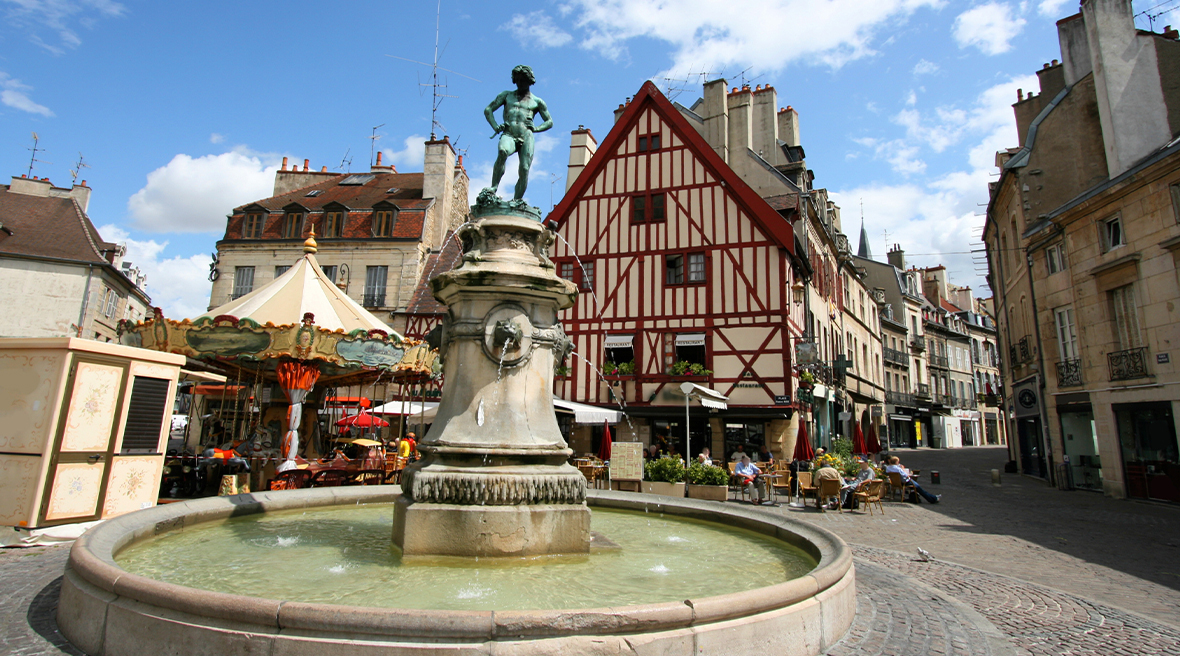
Dijon, France
Dijon
The food and wine of Burgundy are not to be missed, and, when appreciating the region’s wines, it seems only natural to explore the capital, Dijon. This area is well known for fine dining. Whether you’re looking for a romantic meal for two, or a grand French feast, there are countless restaurants to discover.
In the centre of Dijon, Le Bouchon du Palais is famous for serving up exquisite culinary delights from Lyon. Serving up traditional Lyonnaise food, this bouchon is a wonderful place to visit if you love a hearty French meal. With a bustling atmosphere, book ahead before visiting as the restaurant can get a little busy. While the menu is full of rich, flavoursome dishes, the coq au vin can’t be missed!
A little further afield from Dijon, La Ferme de la Ruchotte is a rustic farm using organic home-grown produce. La Ferme serves a set menu featuring a starter, main course, cheese and dessert. The owners, Frédéric and Eva Ménager, are a delight and welcome guests with open arms. They’re incredibly helpful and informative, offering a specially selected wine list.
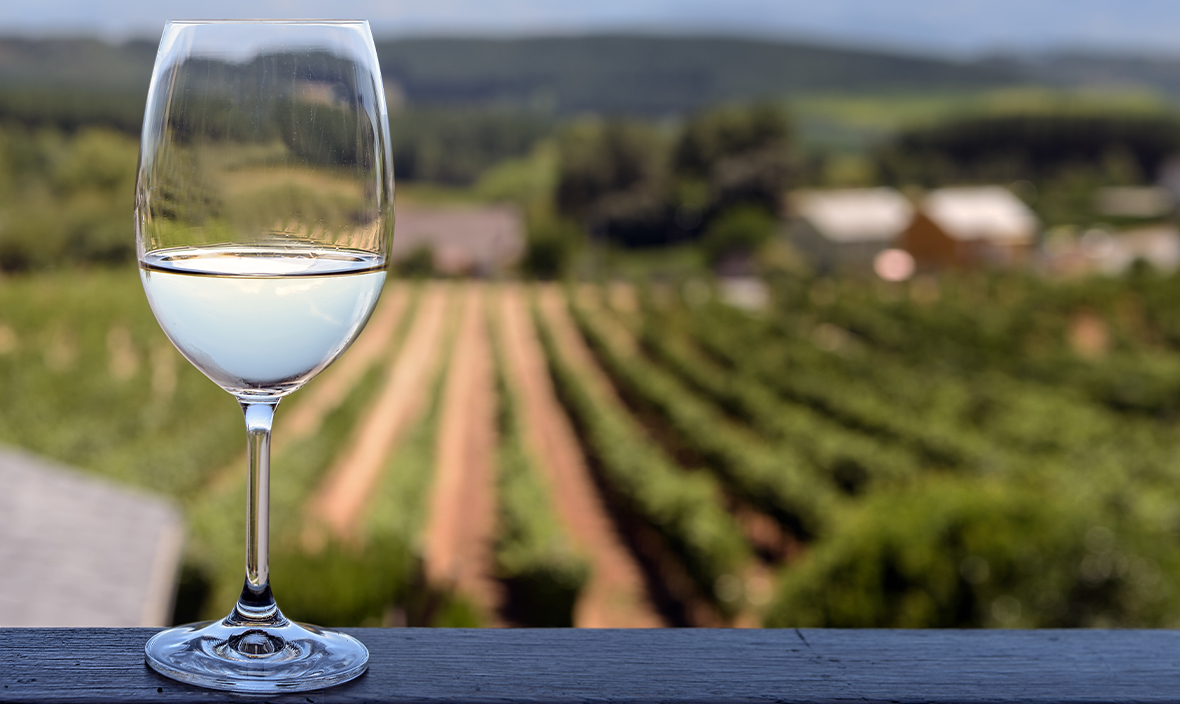
Sample some of the best wines in the region
Chablis
The northernmost wine district of the Burgundy region is Chablis. Wines from here tend to taste a little more acidic as the cool climate takes some of the fruitiness from the grapes. When in Chablis, be sure to visit the Abbaye de Pontigny, founded in 1114. It’s one of the last surviving examples of Cistercian architecture in Burgundy and hosts regular classical music concerts including an annual summer festival.
Worried about wine tasting? We cover everything you need to know about Wine Tasting in France.
Fontenay Abbey
Fontenay Abbey is the oldest preserved Cistercian abbey in the world and now a UNESCO World Heritage site. The Aynard family, descendants of the abbey’s founders maintain this beautiful building and its stunning grounds, making it a wonderful place to wander and explore. See where monks ate, slept and prayed and learn of the abbey’s part in the French Revolution. It was also once a paper mill, so there’s a lot of history here.
Beaune
The heart of the Côte d'Or is the town of Beaune, which is famous for its wine tasting opportunities, even earning the title Burgundy’s wine capital. With such a reputation, the town has its fair share of wine tasting cellars, but there are a few that stand out. Domaine Rion is a family-run winemaker, with a delightfully dusty cellar filled with barrels. With eight hectares of land, their wines are made in the Côte de Nuits wine region, where they create wines such as Clos de Vougeot, a Grand Cru with cherry and black currant aromas. Visit Domaine Rion from Monday to Saturday and enjoy a tour and tasting in their atmospheric cellar.
Beaune is where sumptuous Chablis and Pinot Noir wines can be found, but in the south of the region you’ll find the Gamay wine grape. One of the few places where you can try Gamay in its purest form, there are several vineyards to explore in this part of Burgundy, as well as some to the south of the region.
Vézelay
Vézelay stands on the slopes and top of a hill overlooking the Cure Valley. Filled with medieval houses and quaint cobbled paths, it’s a one-of-a-kind place. Perhaps its main attraction is The Basilica of Saint Marie Madeleine, a UNESCO World Heritage site with a stunning exterior matched by its light-flooded nave. It was specifically designed to be lit in a rather magical way at midday and on the summer solstice. Be sure to stop by the Zervoz museum to see artworks by Calder, Miro and Max Ernst, open daily except on Tuesdays between 15th March and 15th November.
Places to visit in Burgundy
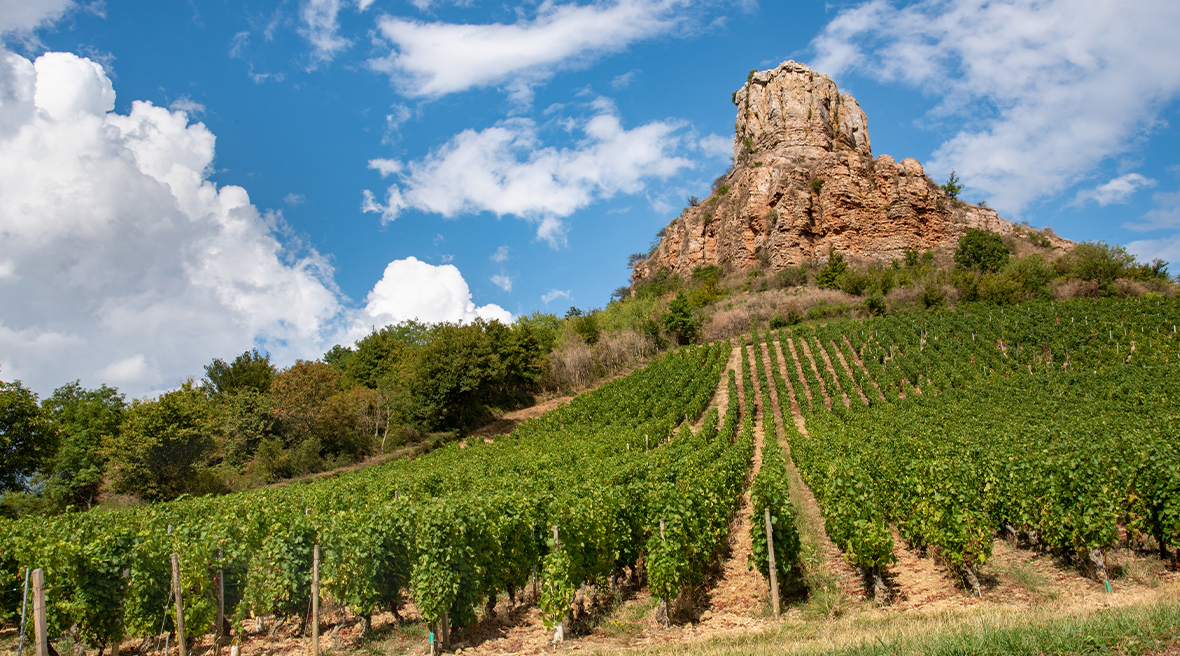
The Rock of Solutré
Rock of Solutré
In the depths of southern Burgundy, the Rock of Solutré juts abruptly out of the landscape. Standing proudly at 495-metres high, it’s thought that the rock has been of great importance since prehistoric times, when it was used as a site to hunt bison and reindeer. Walking through the Mâconnais vineyards surrounding the rock is a real treat and, unsurprisingly, the best views can be found at the top. That said, it’s easy enough to reach the summit in under an hour, and on a clear day you might even see the Alps.
Forêt des Bertranges
After enjoying the region’s delicious food, you might want to get a little exercise. The second-largest oak forest in France, the Forêt des Bertranges is a beautiful place to visit, especially in autumn when the leaves are changing. Near to the pretty commune of La Charité-sur-Loire, the forest is vast, covering about 10,000 hectares, and there are countless walking and hiking routes to explore. You can go mushroom picking and spot deer and other wildlife. You’re also not limited to walking, as there are horse riding and cycling opportunities throughout the forest.
Bourgogne-Franche-Comté
On the border to Switzerland, this region has recently become part of the wider region of Bourgogne-Franche-Comté, and it shares many similarities with its Swiss neighbour in terms of cuisine and architecture. From Calais, you can drive easily to this part of eastern France, passing through the scenic Champagne region, with the option of driving through Dijon. It’s a stunning place, within driving distance of such beautiful lakes as Lake Neuchâtel, which can be found just over the Swiss border.
The home region of famous chef, Raymond Blanc, it’s not surprising that Franche-Comté is famous for its delicious food and drink, with such specialities as Jambon fumé du Haut Doubs (a type of smoked ham) and Poulet de Bresse au vin jaune et aux morilles (Bresse chicken with yellow wine and morels). When exploring this beautiful part of France, don’t miss the Citadel of Besançon, an amazing example of military architecture built in the late 1600s, and the Château d'Oricourt, a 12th century castle.
Beaujolais
Both a type of wine and a region, Beaujolais sits north of Lyon, around 50 miles from the border with Switzerland. Regional wines are named after the local Appellation d’Origine Contrôlée and are primarily made using the Gamay grape. The wines created here are known for their extremely fruity smell, specifically of banana and even bubblegum! This region is great for lovers of hiking and mountain biking as it contains forests, hills and picturesque medieval villages such as Villefranche-sur-Saône (the region’s capital) and Morgon.
Want to visit some of the best vineyards in Europe? Look no further than our guide to them here.
Tournus
The quaint commune of Tournus is a brilliant place to stay during your trip to Burgundy. Nestled alongside the Saone River, its history can be seen through winding alleys and 11th century buildings. Be sure to check out the Hotel Dieu, a 17th century building which was once the city hospital, and the Abbey of Saint-Philibert de Tournus, an ancient Roman-style church, boasting 12th century monastic buildings.
Outside of the town’s many historical sites you can find a selection of superb restaurants. Head to Meulien for a gorgeous four-course menu featuring a starter, main, cheese and dessert, with mains including flavoursome pigeonneau and deliciously tender steak. More fine dining options can be found at the grand restaurant Greuze, while more hearty fare can be enjoyed at Le Bourgogne.
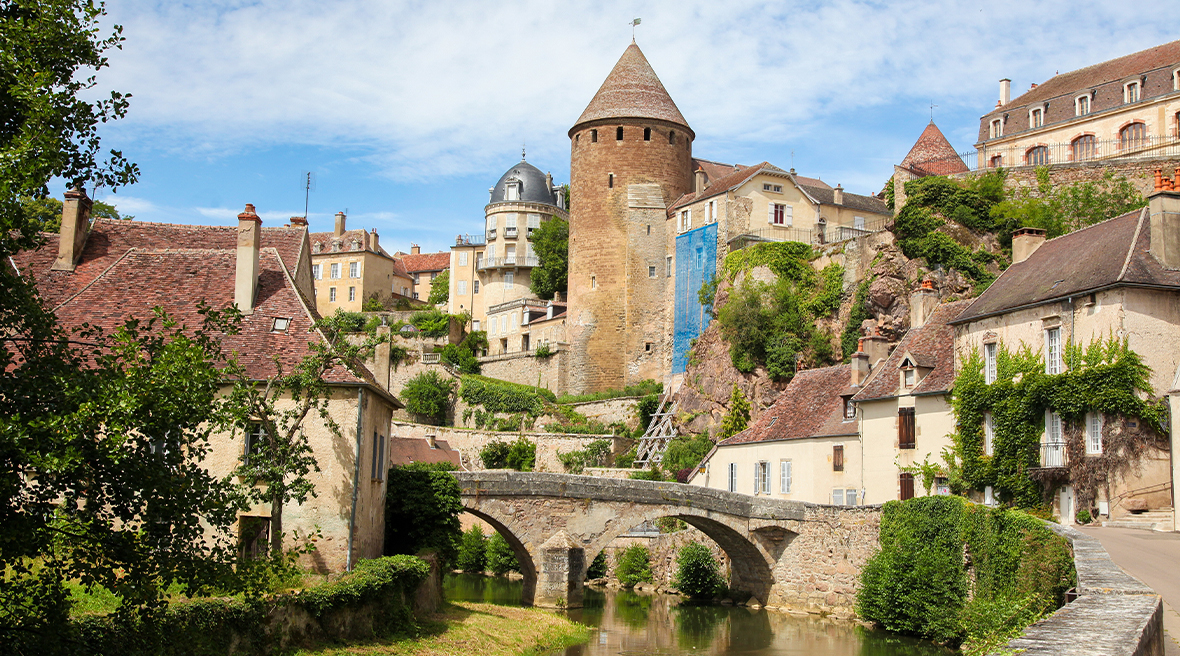
The beautiful town of Semur-en-Auxois, Burgundy, France
Châteauneuf-en-Auxois
Arguably one of France’s prettiest towns, Châteauneuf-en-Auxois is a secret hideaway from Burgundy’s busier towns and cities. Home to the Châteauneuf-en-Auxois castle, which sits alongside the Burgundy canal, the town can easily be spotted during the drive from Dijon to Autun, sitting proudly on the hillside.
There are plenty of shop-lined streets to explore in Châteauneuf-en-Auxois, selling everything from local arts and crafts to coffee and pastries. As well as the Châteauneuf-en-Auxois castle, you can find a chapel with 15th century paintings, plus buildings from the 14th-17th centuries throughout the town.
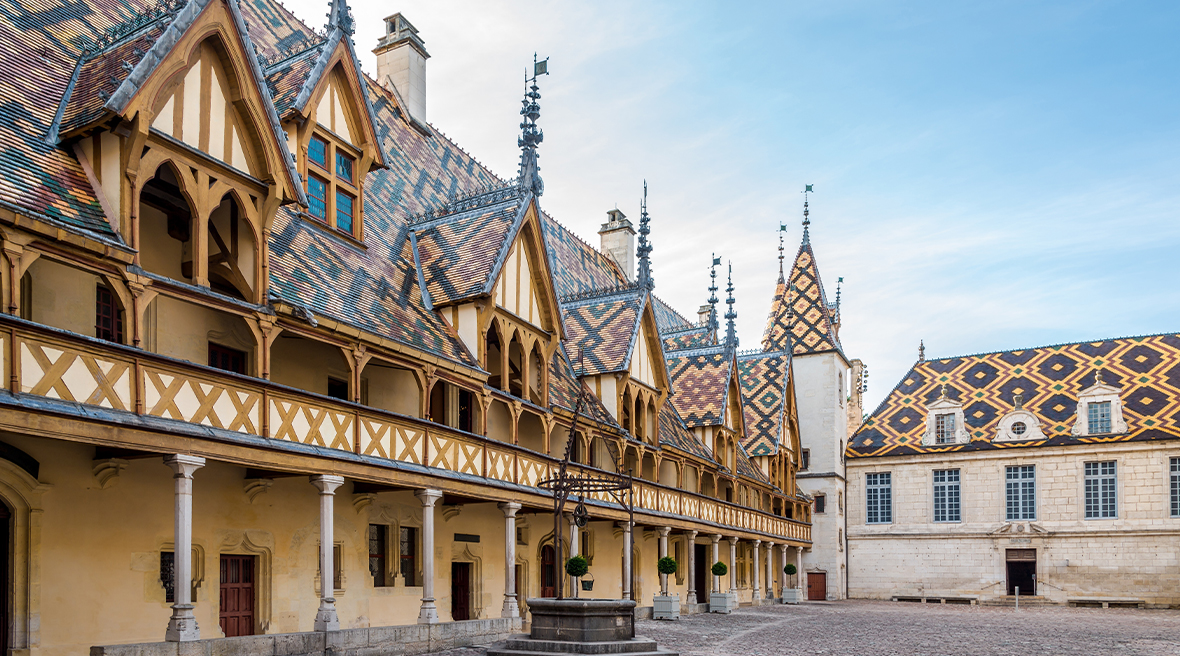
The Courtyard of Hospices de Beaune
The Hospices de Beaune or Hôtel-Dieu de Beaune
These former charitable almshouses in Beaune, France were founded in 1443 by Nicolas Rolin, chancellor of Burgundy, as a hospital for the poor. The original hospital building, the Hôtel-Dieu remains one of the finest examples of fifteenth-century Burgundian architecture and has a museum you can visit. If you plan to visit in November an important charity wine auction is held in the Hôtel-Dieu’s great hall.